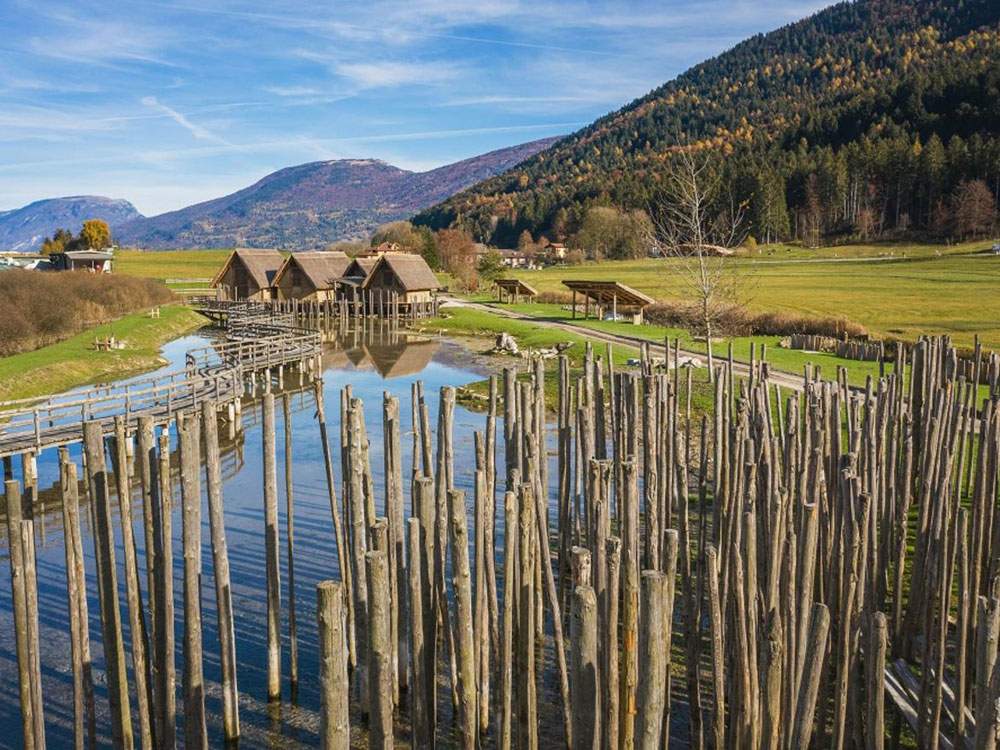Inaugurated in Fiavé is the new Archeo Natura Park to take a plunge into the past in a 3,500-year-old pile-dwelling village and immerse oneself in the world of Bronze Age ancestors. The concept of the trail was developed by Franco Marzatico, archaeologist and superintendent of cultural heritage: visitors to theinnovative open-air museum will be able to walk among the forest of piles and Bronze Age huts reconstructed in full scale and watch various archaeological demonstration activities of metal smelting and pottery making proposed by archaeotechnicians.
Conceived and implemented by the Superintendence for Cultural Heritage of the Autonomous Province of Trento, the Archeo Natura Park covers an area of 12,000 square meters and is nestled in the environmental setting of the nature reserve near the archaeological area where the remains of the piles that supported the prehistoric buildings are still visible. The Fiavé pile dwellings constitute one of the most important and spectacular settlements of European prehistory and are a UNESCO heritage site
The new park began with the first archaeological research conducted by Renato Perini in the 1960s and continued by Franco Marzatico, the current superintendent for the cultural heritage of Trentino, who came up with the concept for the trail. The ancient Carera Lake, which became a peat bog, has preserved for millennia valuable evidence and artifacts unearthed by archaeologists and now partly on display in the Pile Dwelling Museum, located in the center of Fiavé. From the excavation data have come to life the careful reconstructions of the Bronze Age pile-dwelling village, with huts made in life-size and with installations that evoke the “forest of piles,” as it was deffined by the first archaeologists who investigated the pile dwellings.
As soon as the visitor enters the park, he or she is greeted by a special installation: a circular labyrinth created with larch and chestnut poles, echoing the decoration of a Bronze Age vessel found during excavations in the peat bog. Continuing on, the remains of the poles that still emerge from the water in the nearby archaeological area are transformed into a scenic installation, as if time had stood still and invited theexploration of glimpses of life 3,500 years ago. A walkway suspended over the water leads to huts reconstructed on the basis of scientific data, documented in research conducted by archaeologists. They are examples of ante litteram green building with vegetal walls made of a hazel weave, while the unfired earth plaster is made of mortar made from clay, cattle dung, natural binder and chopped straw fibers. Particularly striking are the dense roofing coats made from swamp cane. The refined construction technique of the huts, as well as the ingenious latticework of piles on which the last village piles rested, testify to the skills of the prehistoric inhabitants in craft and agro-pastoral activities, as well as in the raising of domestic livestock. The re-presentation of the village and the activities carried out by its inhabitants lead to reflection on the relationship between man and nature and the ability to adapt to environmental conditions.
The trail is accompanied by information panels in three languages (Italian, German and English) and installations that illustrate village life and the daily occupations of the time: woodworking, metallurgy, pottery making, soil cultivation, grain milling and vegetable fiber weaving. Recalling the activities of farming and hunting are the animals, domestic and wild, made life-size using metal supports covered with peat that are encountered along the way: near the huts the goat, sheep and a bovine, toward the lake and the bush the deer, roe deer, bear and wild boar.
The visitor center is enhanced by films, including a cartoon and multimedia apparatuses. Numerous initiatives are planned over the summer held by the Superintendence’s Educational Services: from workshops to discover ancient techniques and knowledge to participatory guided tours and meetings with archaeologists to explore particular themes.
The park will be open daily until Sept. 10 from 10 a.m. to 6 p.m., in August from 10 a.m. to 7 p.m. From Sept. 11 to Oct. 31 Saturdays, Sundays and holidays from 10 a.m. to 6 p.m.
 |
| Archeo Natura Park is born in Fiavé, at the 3500-year-old UNESCO World Heritage pile-dwelling site |
Warning: the translation into English of the original Italian article was created using automatic tools. We undertake to review all articles, but we do not guarantee the total absence of inaccuracies in the translation due to the program. You can find the original by clicking on the ITA button. If you find any mistake,please contact us.